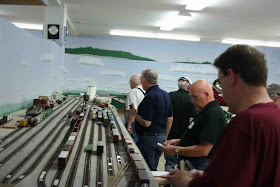Following my usual schedule of First Saturday operations, I just held my thirty-fifth full operating session. In contrast to sessions earlier this year, this one had a light turnout, though just enough for all needed positions to be manned. Operating session attendance ebbs and flows with no particular pattern that I can discern. This session had quite a number of my regular operators down with various medical maladies--the impact of late winter bugs, I guess.
In spite of, or perhaps because of the smaller crew, this became a very successful session in spite of a derailment event toward the end of the session, recorded below. With a low crew count, all but one local freights were run with single man "crews." This may have been a contributor to the easy-flowing successful session. There were less folk in the aisles and less distractions.
In spite of the low crew count, we still doubled up on the Dispatching job, as Vic N. gains experience with the Direct Traffic Control system used on my railroad. Vic dealt with the "valley" portion of my railroad between Eugene and Oakridge. Early on, he had heavy traffic with a couple of through road freights and the Oakridge Turn returning to Eugene via switching at Westfir. This lead to a three-train meet at Springfield.
Vic N. and John B. work the Dispatcher's desk. (David Lange photo)
Later on, more meets took place at Springfield, this time with one of the Springfield local freights in town.
Brigg F. and Craig L. work the First Springfield job (depot side of the mainline) while Jereon G. and Bill M. (just beyond the backdrop edge) guide their through freights through a meet at Springfield.
The Eugene Yard crew works, including the Eugene City Switcher, which serves the industries near the depot.
Meanwhile, other parts of the railroad saw plenty of action. Included in that was a pair of private cars tacked onto the rear of Amtrak Number 14, the northbound Coast Starlight. Salt Creek Trestle is a popular photo spot on my railroad.
Amtrak Number 14 crosses Salt Creek Trestle with a pair of private cars tacked onto its rear.
Later on, an OAEUY (Oakland to Eugene manifest) crosses Salt Creek Trestle. Yes, the photographers were out and about!
Bill M. guides his train past Westfir and through the S-Curve into the Natron Block. I continue to enjoy trains snaking through that S-Curve.
Craig P. held the Assistant Chief Dispatcher job for this session and did a very good job. He successfully got crews assigned (crew caller part of his job) and got the traffic moved over the railroad, completing all trains on the twelve-hour line-up prepared for this session.
Rodger C. and Jim L. successfully got their train into Cascade Summit.
Toward the end of the session we had an operating event that nearly stalled the rest of the session. A slight hiccup on the head-end power on a train climbing into Cascade Summit resulted in too much force applied by the mid-train helper, resulting in a derailment inside the Summit Tunnel. This drew a crowd. Accidents always do--grin. Expecting such an occurrence (a derailment inside a tunnel), my fully-lined tunnels have removable side walls on the room wall side of the tunnels. This still required me to reach up under the layout to remove the panels and then remove the offending cars. This took a fair bit of bending and reaching on my part, but I eventually cleared the derailment. Meanwhile, whenever I popped out from under the layout, I could see most of the operating crew nearby, "supervising" the activity.
I am bending to get in under the Summit Tunnel to clear the derailment inside the tunnel. The rear half of the train has been reassembled to the right of the tunnel on the upper line, while the train crew watches from the platform. (David Lange photo.)
A crowd has been drawn to the scene of the accident, but they grew bored and began watching activity still underway at Oakridge (lower level, left). (John Brock photo.)
The crowd of on-lookers could not resist the photo opportunity. (David Lange photo.)
Eventually I pulled out the last car wedged into the tunnel. (David Lange photo.)
Although one hopes not to have derailments in tunnels, the reality is that they will occur. This was the first serious derailment inside a tunnel for my railroad and the first time I needed to remove a tunnel liner wall. Nonetheless, I am happy I was able to clear the problem after fifteen minutes or so, albeit with a bit of contortion on my part.












It was a very pleasant ops session. Trains were spread out nicely. I'm ready to solo. Vic
ReplyDelete